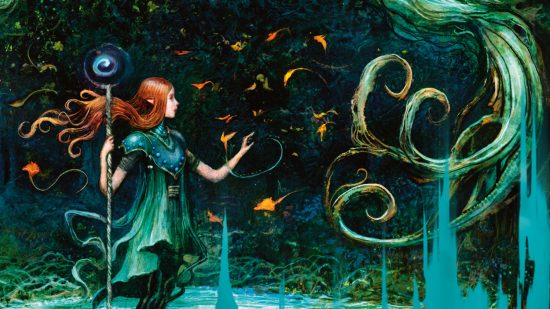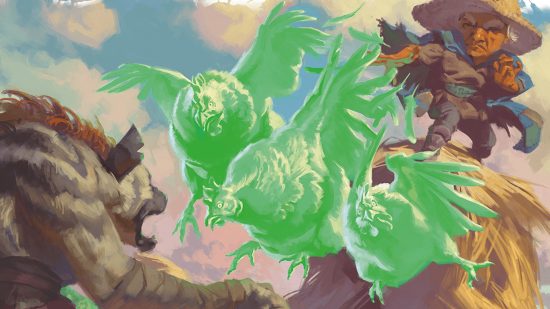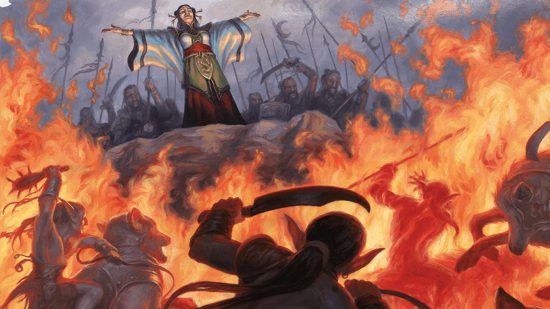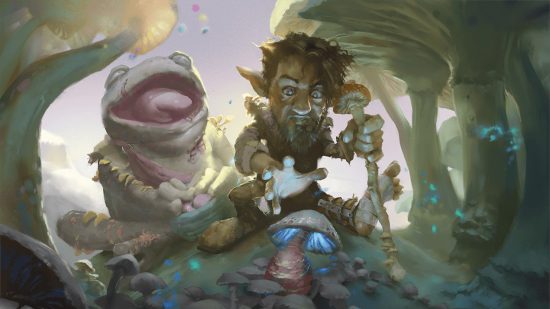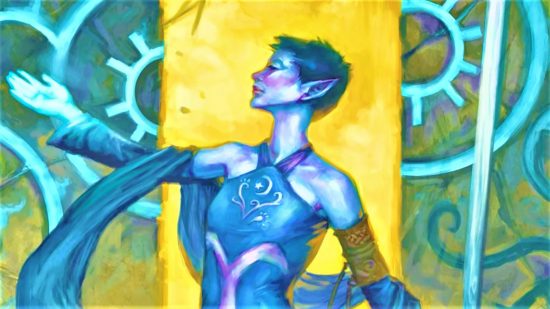We believe there are no bad DnD Druid subclasses – every Dungeons and Dragons player can find a different Druid that suits their needs. Want to tank for your party as a beefy bear? Want full flexibility and a huge range of helpful spells? What about necromancy and zombies? This is a class that can do it all.
Still, there has to be a best and worst among the Druid subclasses 5e offers. If you’re new to the Druid 5e (or DnD classes in general), we can give you the lowdown on each – as well as our personal opinions on which make the best picks.
Here are the DnD Druid subclasses, ranked from worst to best:
7. Circle of Dreams
Found in: Xanathar’s Guide to Everything
The Circle of Dreams Druid has a unique connection to the Feywild, which gives them additional healing and teleportation powers. This is a flavorful subclass that offers some helpful utility to a party, but compared with the other Druid subclasses, it’s a bit lackluster.
In combat, Circle of Dreams has very little to offer on top of a Druid’s core features. You can easily heal allies with a bonus action, and by tenth level you’ll be able to teleport to more advantageous positions. But the subclass’ remaining features offer utility options that can only be used during a short or long rest 5e.
The Circle of Dreams can be situational, and it’s less flexible and powerful than its Druid counterparts. This is by no means a bad choice of subclass, but it’s still the worst a Druid could do.
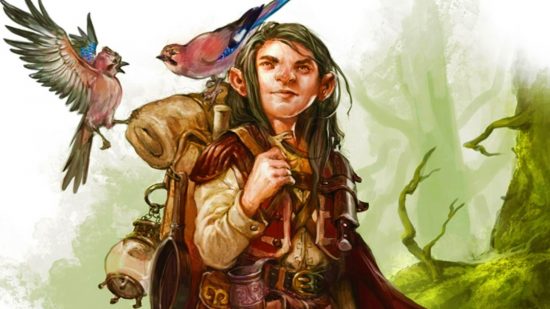
6. Circle of the Land
Found in: Player’s Handbook
A Circle of the Land Druid draws their power from a connection with nature, and they largely translate this power into spellcasting prowess. If the Druid spells list is the main appeal of the class for you, this is a subclass that lets you fully explore that. You’ll learn a bonus DnD cantrip upfront, be able to regain spell slots on short rests, and choose from one of eight possible spell lists.
At higher levels, you’ll become immune to becoming charmed, frightened, or poisoned. You’ll also be better at moving through difficult terrain, and beasts will eventually become hesitant to attack you. These are fairly passive, situational abilities, though – spellcasting is still the main event.
This narrow focus does make Circle of the Land one of the simpler Druid subclasses to play – even if the variety of spell lists gives several levels of replayability. Simple spellcasting builds might not satisfy more experienced players, which pushes Circle of the Land a little lower down our ranked list.
5. Circle of the Shepherd
Found in: Xanathar’s Guide to Everything
The Circle of the Shepherd Druid is best known for their ability to summon beasts and nature spirits. You can choose one of three spirits, each of which emits a certain aura in a 30-foot radius. These provide healing, attack roll advantage, or advantage on ability rolls – and at high enough levels, they’ll even protect you when you’re downed.
Any regular beasts summoned by this Druid subclass gain extra buffs to their health and attacks, plus they’re protected by your nature spirits when they share a battlefield. Given the wide range of benefits your nature spirits provide and how helpful extra bodies can be in a fight, this is a highly versatile Druid subclass.
Nevertheless, this subclass is somewhat limited by its specific playstyle. The Circle of the Shepherd focuses on buffing your summons rather than you, and with far fewer spells than your fellow Druids, it’s easy to feel like you’re playing second fiddle to your animal friends.
4. Circle of Wildfire
Found in: Tasha’s Cauldron of Everything
The Circle of Wildfire recreates fire’s ability to create and destroy life. Mechanically, this manifests as an equal balance of healing and fire-based offensive spells. Druids of this subclass can also summon a pet wildfire spirit, which deals fire damage to anything that gets too close.
At later levels, your wildfire buddy can also buff your spells. After even more DnD level ups, you’ll use the spirits of foes you’ve incinerated to further heal or harm others on the battlefield, and your wildfire spirit will be able to save you from near-death.
If you want to feel useful in combat, this is an excellent choice of Druid subclass. Its main drawback, however, is its reliance on fire damage. This is a very common resistance for DnD monsters, so certain combat scenarios may leave you feeling like a snuffed candle.
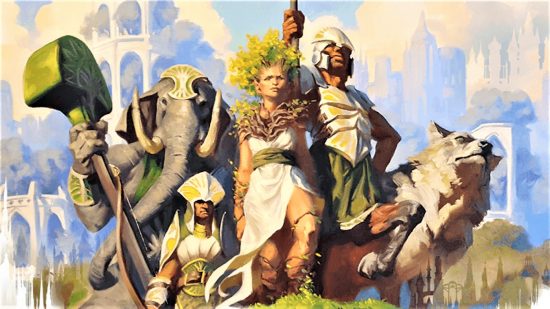
3. Circle of the Moon
Found in: Player’s Handbook
The Circle of the Moon heavily emphasizes one of the Druid’s most unique features – DnD Wild Shape. As part of this Druid subclass, you can Wild Shape as a bonus action instead of an action, and you can spend a bonus action during Wild Shape to regain 1d8 hit points per spell slot level used.
Circle of the Moon members can shift into more powerful creatures far sooner than other Druids. Later on, your attacks in animal form count as magical, and the power level of your Wild Shape options grows even further. You’ll eventually be able to spend two Wild Shape uses at once to turn into an elemental.
The extra hit points, more powerful forms, and economic use of bonus actions turn the Circle of the Moon Druid into a combat powerhouse. You’ll still only have two Wild Shape uses per long rest for most of the game, though – so you likely won’t be optimized for every fight the DM throws at you.
2. Circle of Spores
Found in: Tasha’s Cauldron of Everything / Guildmaster’s Guide to Ravnica
The Circle of Spores is one of the most unique Druid subclasses, both in flavor and mechanics. This is a Druid that values the balance between life and death, and they use the power of fungi and spores to heal and harm in equal measure. It won’t surprise you to learn that you’ll eventually be able to summon Last-of-Us-style DnD zombies, but you might be shocked to learn that this Druid is a monster in melee.
Circle of Spores Druids are constantly surrounded by spores. They can spend an action and a use of Wild Shape to turn these into heaps of temporary hit points and extra melee damage, or they can spend a reaction to take plant-based pot shots at nearby foes. Higher levels give you zombies, clouds of damage-dealing spores, and immunity to a whole host of conditions (and critical hits).
The Circle of Spores isn’t perfect – necromancy spells and undead summons never feel quite as powerful as we want them to. But this is a tank-y Druid that feels awesome in battle with the right DnD character build. Plus, you’re never going to struggle with a boring backstory.
1. Circle of Stars
Found in: Tasha’s Cauldron of Everything
The Circle of Stars Druid uses the constellations to gain its power. You’ve got a constellation map that helps you cast spells (including some handy ones from the Cleric 5e list), and you can Wild Shape into a celestial being rather than a common animal.
When you Wild Shape, you choose whether your form gives you an extra bonus action ranged attack, the ability to deal out extra hit points, or better concentration on 5e spells. At higher levels, your map can buff or debuff rolls at your whim, and your starry form goes from strength to strength. There’s a nice mix of combat, healing, and utility to work with here.
The Circle of Stars has a finger in all the most important pies. It feels good in supportive and offensive roles, and it strikes a nice balance between beginner-friendliness and complexity. It’s got a unique identity, and yet it still doesn’t stray too far from the classic D&D Druid concept. Whatever your style or experience level, Circle of Stars is a great choice.
For more character options, here’s everything you need to know about DnD races. We can also point you to more ranked lists for the classes – here’s how the Ranger subclasses 5e and DnD Paladin subclasses measure up.
Source: Wargamer



